
Your Source For Xanthoceras Sorbifolium / Shiny Leaf Yellow Horn
Phone: (989)743-4344 or Email: don@mapleriverfarms.com
Introduction:
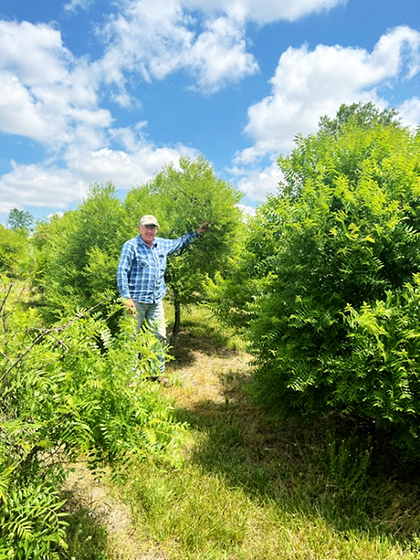
Some of our more mature trees.
In an attempt to find an alternative energy bio-diesel source, Maple River Farms came across Xanthoceras Sorbifolium, a northern, cold hardy, oil tree. In 2012 we began establishing our orchard with the hope of integrating this crop into out alternative energy endeavors. At this time we have seeds/nuts and tree seedlings for sale and tea coming soon.
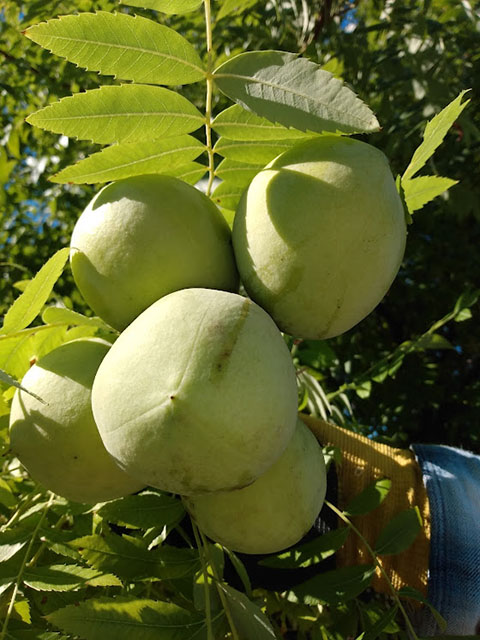
Sets of capsules produced from
a tree in our orchard.
During years of growth and working with this tree we discovered that it offers a multitude of cooking and medicinal possibilities. The seeds of Xanthoceras Sorbifolium are rich in unsaturated fatty acids and are used to prepare cooking oil. The leaves can also be used as tea (its protein content is higher than that of black tea), and the caffeine is similar to that of flower tea. Xanthoceras Sorbifolium can also be used in cosmetics and to make biodiesel. Other properties of this plant include cold tolerance, soil resistance, and high seed oil content.
Xanthoceras Sorbifolium has broad development prospects, especially in fields of food, medicine, energy, and ecology. In recent years phytochemistry research has isolated 278 components from different sections of Xanthoceras Sorbifolium, including triterpenoids, flavonoids, phenylpropanoids, steroids, phenols fatty acids, alkaloids, quinones, and others.

Great article by a US collegiate researcher at
Doña Ana County Cooperative Extension Service.
The following links explain the potential for this plant...
https://donaanaextension.nmsu.edu/documents/yellowhorn24.pdf
https://www.researchgate.net/publication/354350761
_Xanthoceras_sorbifolium_Bunge_A_Review_on
_Botany_Phytochemistry_Pharmacology_and_Applications
https://www.frontiersin.org/articles/10.3389/fnut.2023.1087256/full
Products:
We offer tree seedlings and seeds/nuts at this time.
Seeds/Nuts:
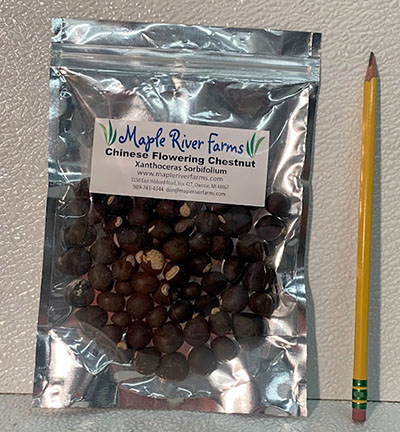
50 Seed/Nut Bag - $17.00
Flat Rate Shipping - $4.60
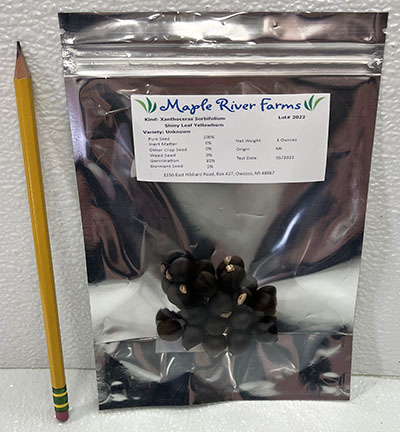
10 Seed/Nut Bag - $7.00
Flat Rate Shipping - $4.60
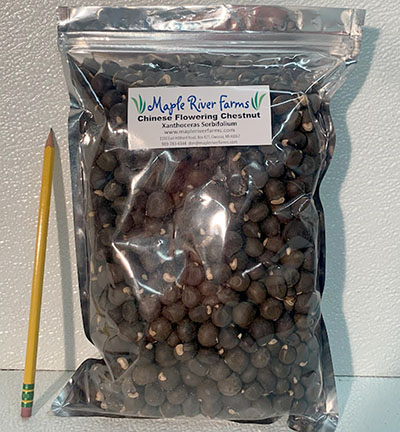
2lb Seed/Nut Bag - $200.00
Flat Rate Shipping - $10.00

300 Seed/Nut Bag - $90.00
Flat Rate Shipping - $7.00
We are selling 10 Xanthoceras Sorbifolium seeds/nuts for $7.00 plus $4.60 flat rate shipping so you can have this rare tree growing in your area. We have 50 seed/nut bags for $17.00 plus $4.60 flat rate shipping. We have 300 seed/nut bags for $90.00 plus $7.00 flat rate shipping. We also have 2lb bags, containing about 800 seeds, available for $200.00 plus $10.00 flat rate shipping.
We ship the seeds/nuts through USPS in a clear/silver resealable bag.
We have found a new germination method that has brought our germination rate close to 90% again. After much experimentation we now use a "live" soil that is very moist. The mix is 50% seeds, 50% soil then right to warmth. The idea is to make good soil contact with the hilum "the eyes". The quickest seed will germinate in 7 days, majority weeks later. Zip-lock bags work for smaller amounts. Check container every 2 days after the initial 7 days.
Germinated Seeds:

5 Germianted Seeds
Xanthoceras Sorbifolium
Our germinated seeds are temporarily sold out until the batch.
We have 5 Xanthoceras Sorbifolium already germinated seeds for $20.00 with $5.00 flat rate shipping. Right now they need to be placed in a deep pot, at least 10 inches, for indoor growth until spring. We are checking for new seeds every other day. It may take around 3 days until they are shipped.
Tree Seedlings:
Please call for availability.
Individually potted tree seedlings available. They are about 4 - 6 inches tall in 2 inch tree pots.
Seedlings are available for pickup and shipping for $25.00 per tree.
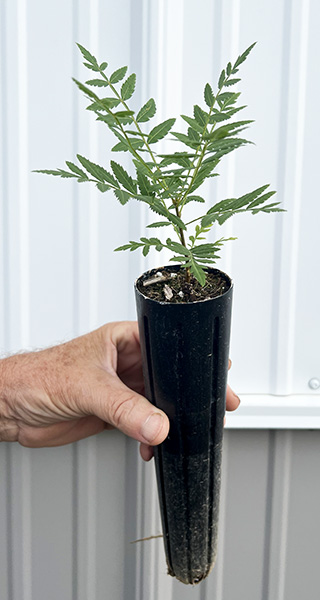
Potted Xanthoceras Sorbifolium
Tree Seedling
1 Seedling: $36.00 - Shipping Included
2 Seedling: $61.20 - Shipping Included
3 Seedling: $87.30 - Shipping Included
4 Seedling: $112.75 - Shipping Included
5 Seedling or more, please call for shipping quote.
An Idea for a 9 Tree Home Productive Orchard with
Maximum Use of Space with Minimum (Cost) Protective Fencing:
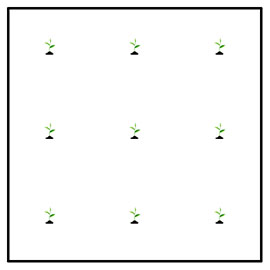
9 tree planting grid with
5 foot spacing.
A 15' square fenced in enclosure with 9 trees planted on a 5' grid (See Illistration).
Thinning will be required but not for many years.
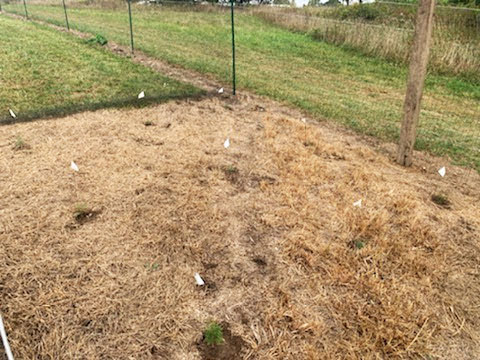
9 Trees / 5' Grid / 15' Enclosure.
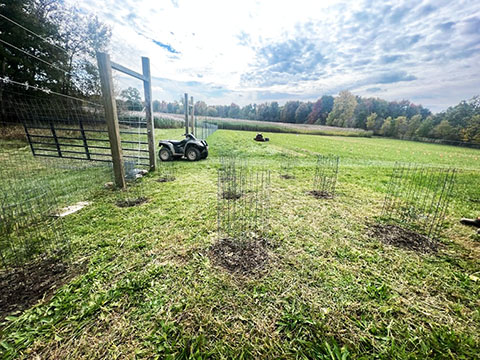
9 Trees / 5' Grid / 15' Enclosure.
International Shipping:
The seedlings aren't available for international shipping. Please contact us if interested in seeds/nuts for availability and shipping quote. All sales will also have a handling fee.
Planting Zones:
USDA hardiness zones 4 - 7
Range: E. Asia - N. China
UK hardiness zone 6
Information:
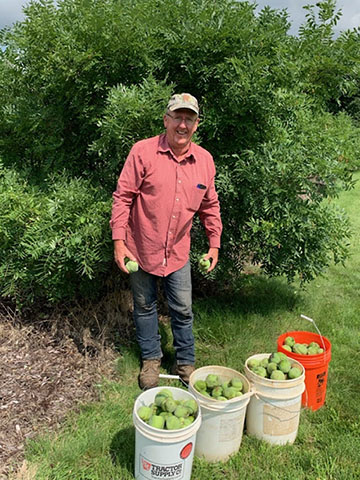
This 9 year old tree produced 20 gallons
of capsules containing nuts.
The following article about Xanthoceras Sorbifolium is very well written. Mark Dwyer wrote this article for Nursery Management magazine. They have given us permission to use their wonderfully informative article on our website...
Blooming in May, the fragrant flowers, appearing on terminal racemes, are white with very light green streaks and a center that age from yellow on the newest flowers to a gorgeous red orange on older flowers. The proliferous flower clusters can be up to 10 inches long and individual flowers are roughly 1 inch in dimeter with five petals.
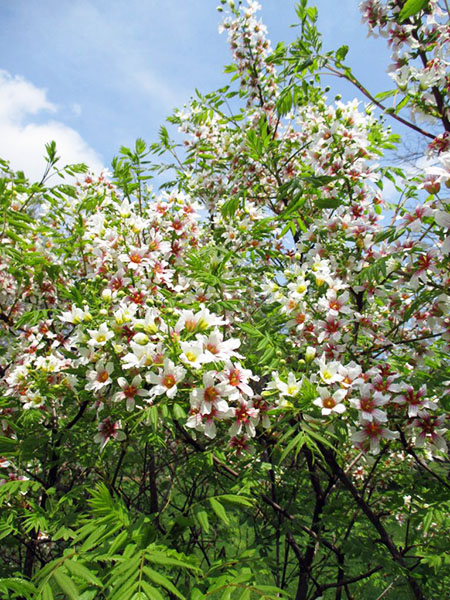
Xanthoceras Sorbifolium
tree in full bloom.
Another common name for this plant is "popcorn shrub" due to the appearance of the flowers upon opening. The duration of bloom is only about two weeks, but it is a gorgeous and memorable display. Plants as young as two to three years old will start to bloom readily. William (Ned) Friedman of the Arnold Arboretum (Harvard University) writes about the value of the yellow to red color shifts in the flowers of Yellow Horn and other woodies with similar flowering characteristic. Ecologists have shown that insects have an innate preference for yellow flowers over red and by targeting the younger with yellow accents; they are assured of more nectar and pollen. Those that have faded to red have likely been visited already. Friedman mentions that this yellow to red color shift has evolved to help steer insects to newly opened flowers.
The fruits, more common on older specimens, are 2 1/2–inch, pear–shaped, leathery capsules. The capsules are initially green and resemble a black walnut husk but later age to a brown and split open into three chambers that contain the glossy, pea–sized black seeds. The half–inch seeds are edible and when roasted, have the flavor of macadamia nuts. The seeds are also used to produce quality cooking oil and aside from being roasted, can be boiled or dried and ground into flour. Apparently, this plant also has edible flowers and foliage which are traditionally boiled in advance of consumption.
Yellow Horn can be found in Beijing, China as a small urban tree and is also commonly found throughout a wide range of other urban settings. There are actually large plantations of Yellow Horn in China as the seeds are showing great promise as a highly suitable biofuel.
Yellow Horn is commonly propagated from seed or cuttings (stem and root suckers). A higher germination rate for the seeds has been observed with three months of cold stratification. Soaking the seeds for 24 hours before sowing combined with scarification is also recommended by some sources.

Capsules splitting open after harvesting
The first challenge in growing Yellow Horn initially starts with sourcing it. Finding this plant will certainly be a quest but ultimately worth the time. This unique and beautiful woody plant has impressed those that have grown it over the many years since it was introduced into cultivation.
In the landscape
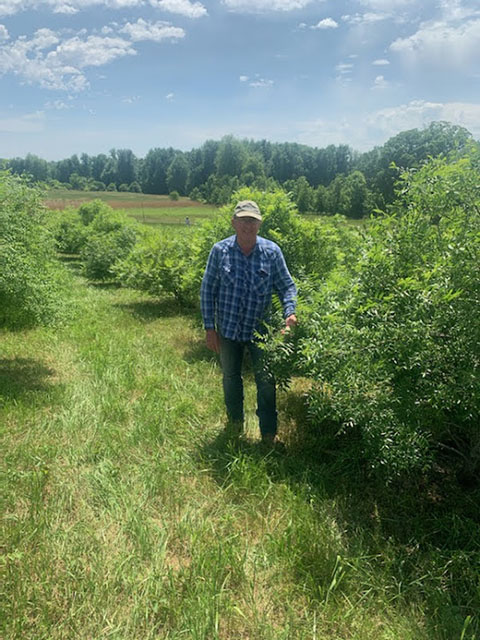
Our Shiny Leaf Yellowhorn orchard.
Yellow Horn doesn't mind slight dampness but is quite sensitive to excessive moisture or heavier soils that stay wet. In general, this plant isn't overly picky about soil although again, drainage is important. A loamy soil would be ideal but isn't essential for the success of this durable woody plant and slightly acidic to slightly alkaline soils are just fine. a pH range between 5.5 and 8.5 is recommended. Yellow Horn is very sensitive to too much shade where it will simply not thrive or flower well. A full sun location is ideal as is plenty of summer heat associated with that exposure. This plant has no significant insect or disease problems although coral spot fungus has been observed on occasion.
Keep in mind that Yellow Horn also flowers on old wood so any pruning should be accomplished immediately following the bloom cycle similar to the approach with lilacs (Syringa). An isolated Yellow Horn can still flower and fruit although multiple specimens will assure more significant fruiting.
Whether Yellow Horn is used as a specimen plant, in a mixed border or as spring feature in a prominent location, it certainly deserves broader awareness, availability and enjoyment of its attributes.
Mark Dwyer was the Director of Horticulture as Royal Botanical Gardens in Janesville, Wisconsin, for 21 years. He has degrees in landscape architecture and urban forestry and now operates a private consulting practice, Landscape Prescriptions by MD. www.landscapeprescriptionsmd.com.
To Make:
Oil

Xanthoceras Sorbifolium Nut Oil
From 1 pound of nuts (approximately 400) we get about 25% oil by weight. This unit in the photo has a heating element which helps on higher oil recovery. When pressing with whole seeds there is no bitter aftertaste in the oil.
Tea

Shiny Leaf Yellow Horn Tea
The leaves from the tree make a great herbal green tea. We add a few drops of monk fruit sweetener to make it even better. One serving size is 0.05 oz. We will have tea leaves and steeping instructions available soon.
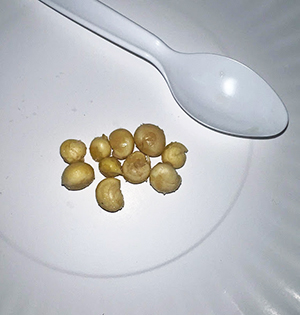
Roasted Nuts
The kernels are edible raw or see the roasted nut recipe below to lessen the slight bitter after taste.
Roasting Nut Recipe
| 40 Nuts | Liquid smoke |
| 16.9 oz bottle water | 31/2 tablespoons salt |
Place nuts in pan cover with salt water mixture and bring to a boil. Once boiling, continue to boil for 8 minutes. When the 8 minutes is up remove nuts from water, pat dry and place in a pre-heated 350 degrees oven for 8 minutes. After roasting for 8 minutes remove and shell the nuts and put the nutmeat (kernel) in one cup water mixed with a teaspoon of liquid smoke. Soak for 5 minutes remove nuts from solution and toss in salt if desired.
10 Shiny Leaf Yellowhorn contains approximately 100 mg of nervonic acid. Suggested daily dosage of nervonic acid is thought to be between 200-400 mg split between a morning does and an evening dose.

